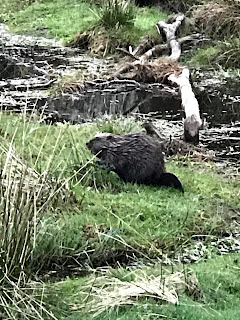Summer’s lease hath all too short a date.
A riparian and wetland rewilding project at Bamff in Perthshire, Scotland in which Eurasian beavers (Castor fiber) play a key part.
Tuesday, 15 December 2020
Summer's lease hath all too short a date.
Thursday, 18 June 2020
June 2020
18th June.
Here is a piece that I wrote for July's 'Alyth Voice', but didn't send because something more exciting came up and I decided to write that up and send it in as my contribution.
The WhatsApp message announced itself with a ‘Ping!’ The message was brief it said get your act together and produce something for the ‘Voice’. Of course I must do that: so it’s on with the boots, stick at the ready and, with my binoculars around my neck, I stride out. Beyond the herbaceous border of Bishop’s weed in full bloom I pass the row of lime trees at whose feet a bank of Siberian Purslane displays its pink flowers. This species is described as being originally from western North America, not Siberia as its scientific name, Montia sibirica (Claytonia sibirica is a synonym), suggests, but I see from its entry in Wikipedia that its range does include the Commander Islands, the westernmost of the Aleutian Islands in the Bering Straits. Striding past this gathering of incomers, which have been here since the eighteenth century (their leaves are good in salads,) there is an assembly of yellow flowered Wood Avens, some of whose stems are decorated with cuckoo spit. I wonder if I will see any of this plant’s near relation the Water Avens with its drooping head and pinky purple flower - I am sure that there are some further down the drive. These two species are closely enough related to hybridise freely, which always seems odd to me because, superficially at least, the flowers look so different. Past the trees, the drive side verge is grassed out. We are at that time of year when grasses, particularly the agricultural species, are reaching the peak of their annual growth and coming into flower. I notice some Timothy whose stamens are heavy with golden pollen, waiting to be carried away by the wind.
Left along the Burnieshead path: yesterday evening wrens were cacophonous. The young were trying out their wings. A week before Greater spotted woodpecker fledglings were making a tremendous noise up in their hole in a dead sycamore tree: their parents were flying about the nest, apparently distracted by their offspring. The woodpeckers are quiet now. I suppose the young have fledged and flown. On the water the mallard duck with her brood of seven continues to supervise their activities. A couple of weeks ago I watched with amazement as the ducklings attacked a hatch of mayflies, or some other aquatic invertebrate. They darted about snapping at the insects. A few days later I saw them busy again, hunting for something on the surface. Some were upending. It was as though they were getting lessons in hunting and gathering. All the while their mother sailed along, watchful and attentive. In the meantime the moorhen pair still have one of their first brood of chicks, the other six having disappeared. Otters were around at the time of this disappearance and I haven’t seen them since. I wondered if the moorhens would try to breed again. One evening I saw a couple of young with one of the adults.
The ferns are now fully grown. It is a pleasure to see a beaver swim over to the bank and then, some moments later, swim back to the lodge with ferns trailing from its mouth. I used to think that ferns were good only for bedding, but I have learned that the male fern (Dryopteris files-mas), one of our commonest species, is valuable nutritionally. I walk on. A roe doe in her brilliant summer coat of chestnut red bounds out of the young regenerating birch. Bumble bees forage in the broom and foxgloves are massing in the clearings, ready to burst into purple and white.
Walking back up the drive after the circuit that has taken me by the Old Drove Road, a new bicycle path through the Steffort Woods and on to Cold Corner, I see Water Avens flowering and scattered groups of columnar purple bugle. All through the beaver wetlands along the drive the willow and birch regeneration is flourishing. The yellow flag will be out soon and I notice knapweed readying itself to flower. The seasons advance. It is high summer.
















